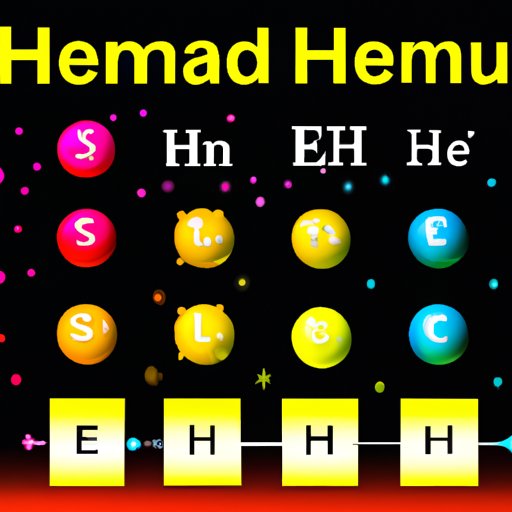Introduction
Elements are fundamental components of the universe that make up everything from stars and planets to human life. While there are over 100 known elements, some are far more abundant than others across the universe. In this article, we will explore the most common elements in the universe and how they shape our understanding of space.

Analyzing the Abundance of Elements Across the Universe
When it comes to understanding the elements in the universe, the first step is to analyze their abundance. This involves looking at how much of each element is present in different galaxies and regions of space. To do this, scientists use a range of techniques, such as spectroscopy and X-ray imaging.
What elements are most abundant in the universe?
The most abundant element in the universe is hydrogen, which makes up around 75% of all matter. Helium is the second most abundant element, accounting for around 24%. Other elements, such as oxygen, carbon, neon, and nitrogen, make up the remaining 1%.
How do we measure element abundance?
Element abundance can be measured using spectroscopy, which is the process of analyzing light from stars and galaxies to identify their chemical composition. By measuring the amount of light emitted by an element, scientists can determine how much of it is present in a given area of space.
What trends can be seen across different galaxies?
The abundance of elements varies from galaxy to galaxy. For example, some galaxies contain more helium than others, while some have higher concentrations of heavy elements such as iron and nickel. These variations can be attributed to the age and size of the galaxy, as well as its star formation history.
Exploring the Chemical Composition of the Universe
When looking at the chemical composition of the universe, it is important to consider the elements that make up the majority of space. These elements are typically referred to as the “building blocks” of the universe and include hydrogen, helium, and other light elements.
What are the most common elements in space?
Hydrogen and helium are the two most common elements in space, making up around 99% of all matter. Other elements, such as oxygen, carbon, neon, and nitrogen, make up the remaining 1%. These elements are often referred to as “heavy elements” because they are heavier than hydrogen and helium.
How does the chemical composition differ from galaxy to galaxy?
The chemical composition of galaxies varies depending on their age and size. Younger galaxies tend to have higher concentrations of heavy elements, while older galaxies have lower concentrations. Additionally, larger galaxies tend to have more heavy elements than smaller ones.
How Do We Know These Elements Exist?
In order to understand the elements in the universe, scientists need to be able to detect them. This is done through a range of methods, including spectroscopy and X-ray imaging.
The Role of Spectroscopy
Spectroscopy is the process of analyzing light from stars and galaxies to identify their chemical composition. By measuring the amount of light emitted by an element, scientists can determine how much of it is present in a given area of space.
Other Methods of Detection
In addition to spectroscopy, scientists can also use X-ray imaging to detect elements in space. X-rays are high-energy waves that can penetrate through dust and gas clouds, allowing scientists to map out the chemical composition of galaxies.

The Role of Hydrogen and Helium in the Universe
Hydrogen and helium are the two most common elements in the universe, making up around 99% of all matter. These two elements play an important role in shaping the universe, from the formation of stars to the evolution of galaxies.
What is the significance of hydrogen and helium?
Hydrogen and helium are the building blocks of the universe. They provide the fuel for stars, enabling them to generate energy and light. Additionally, these elements are essential for the formation of planets, as they are the primary components of gas giants like Jupiter.
How do these two elements shape the universe?
Hydrogen and helium are the most abundant elements in the universe, meaning they have a major influence on the structure and evolution of galaxies. For example, the ratio of hydrogen and helium in a galaxy can tell us a lot about its age and size. Similarly, the abundance of other elements can give us clues about the star formation history of the galaxy.
Conclusion
This article has explored the most common elements in the universe and how their presence is measured. We looked at the chemical composition of space, the role of spectroscopy, and the significance of hydrogen and helium. From this, we can see that these elements play an important role in the evolution of the universe, from the formation of stars to the structure of galaxies.
Despite our current understanding, there is still much to learn about the elements in the universe. As technology continues to improve, we may gain further insight into how these elements shape the cosmos. Therefore, further research is recommended to continue exploring the most common elements in the universe.


